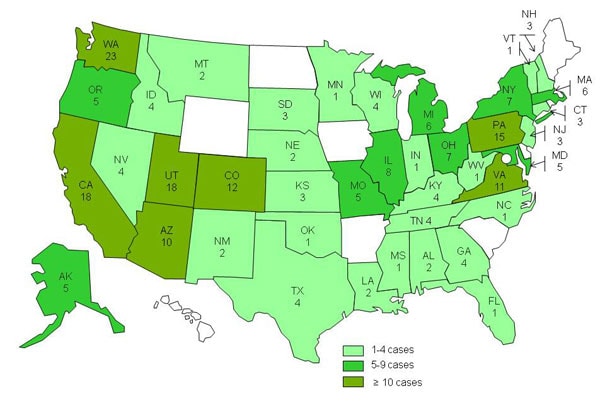E.coli outbreak is spreading through Europe. As of June 1, more than 1,500 people are infected in Germany, source of E.coli cases remains unknown. The death toll rose to 16 with the first death outside of Germany, in Sweden.
There were more outbreaks of Salmonella Typhimurium infections associated with African dwarf frogs and clinical/teaching microbiology laboratories.


Fewer people were infected with another type of Salmonella, Salmonella Panama from Cantaloupe: Oregon (5 cases), Washington (4 cases), California (2 cases), Colorado (1 case) and Maryland (1 case). Dates of illness onset ranged from February 5, 2011 to March 4, 2011. 62% were male.
Why is this strain of E. coli 0104:H4, 93% similar to EAEC 55989 with several antibiotic-resistant genes, so virulent? Was there something wrong with lettuce, tomatoes or cucumbers? Is it safe to eat vegetables?
These questions remain unanswered.
All we know is that women account for most of the cases, while young and middle-aged adults are most severely affected. Kidney failure appears to be a signature of this E.coli.
Meanwhile all is quiet on the foodborne outbreak front in the US.
There were 8 E.coli cases (serotype O157:H7) reported in April (1 in Michigan, 3 in Minnesota and 4 in Wisconsin). 75% of infected were males. These cases were associated with in-shell hazelnuts.
14 more E.coli cases (serotype O157:H7) reported in April (3 in Maryland, 2 in New Jersey, 1 in North Carolina, 2 in Ohio and 6 in Pennsylvania) were associated with Lebanon Bologna.
There were more outbreaks of Salmonella Typhimurium infections associated with African dwarf frogs and clinical/teaching microbiology laboratories.
Persons infected with the outbreak strain of Salmonella Typhimurium from frogs

As of May 9, 2011, a total of 222 individuals infected with the outbreak strain of Salmonella Typhimurium have been reported from 41 states (statistics since April 1, 2009). The number of ill person identified in each state is as follows: Alaska (5), Alabama (2), Arizona (10), California (18), Colorado (12), Connecticut (3), Florida (1), Georgia (4), Idaho (4), Illinois (8), Indiana (1), Kansas (3), Kentucky (4), Louisiana (2), Massachusetts (6), Maryland (5), Michigan (6), Minnesota (1), Missouri (5), Mississippi (1), Montana (2), North Carolina (1), Nebraska (2), New Hampshire (3), New Jersey (3), New Mexico (2), Nevada (4), New York (7), Ohio (7), Oklahoma (1), Oregon (5), Pennsylvania (15), South Dakota (3), Tennessee (4), Texas (4), Utah (18), Virginia (11), Vermont (1), Washington (23), Wisconsin (4), and West Virginia (1).
Persons infected with the outbreak strain of Salmonella Typhimurium from microbiology labs
As of April 20, 2011, a total of 73 individuals infected with the outbreak strain of Salmonella Typhimurium have been reported from 35 US states: AK (1), AL (3), AZ (2), CA (1), GA (5), IA (1), ID (2), IL (3), IN (1), KS (1), KY (3), MA (2), MD (2), MI (2), MN (4), MO (2), NC (1), ND (1), NE (2), NJ (2), NM (3), NV (1), NY (1), OH (1), OK (1), OR (1), PA (6), SC (2), SD (1), TN (2), TX (1), UT (3), WA (5), WI (3), WY (1).
Fewer people were infected with another type of Salmonella, Salmonella Panama from Cantaloupe: Oregon (5 cases), Washington (4 cases), California (2 cases), Colorado (1 case) and Maryland (1 case). Dates of illness onset ranged from February 5, 2011 to March 4, 2011. 62% were male.
US foodborne outbreaks: 2011 stories
- Microbiology Laboratories - Salmonella Typhimurium
- African Dwarf Frogs - Salmonella Typhimurium
- Turkey Burgers - Salmonella Hadar
- Lebanon Bologna - Escherichia coli O157:H7
- Del Monte Cantaloupe - Salmonella Panama
- Hazelnuts - Escherichia coli O157:H7
